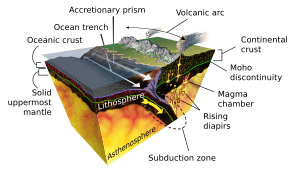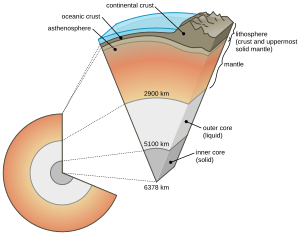Asthenosphere facts for kids
The asthenosphere is a special layer inside Earth, found in the upper mantle. It sits right below the lithosphere, which is Earth's outermost, rigid layer. This squishy layer starts about 80 to 200 kilometers (50 to 125 miles) below the surface. It can go as deep as 700 kilometers (435 miles), but its exact bottom edge is not always clear.
The asthenosphere is mostly solid rock, but it's a bit soft and can flow very slowly. This happens because a tiny amount of the rock (less than 0.1%) is melted. This slight melting makes the asthenosphere weak and allows it to move. When this layer rises, more melting can happen because the pressure decreases. This process is the main way magma (molten rock) is created on Earth. This magma forms new rock at mid-ocean ridges and also feeds volcanoes above subduction zones or in areas where continents are pulling apart.
Contents
What Makes the Asthenosphere Special?
The asthenosphere is a crucial part of the upper mantle. It plays a big role in plate tectonics, which is the movement of Earth's huge plates. It also helps with isostatic adjustments, which is how Earth's crust balances itself. This layer is made of a type of rock called peridotite. Peridotite mostly contains minerals like olivine and pyroxene.
The boundary between the lithosphere and the asthenosphere is usually where the temperature reaches about 1300 degrees Celsius (2372 degrees Fahrenheit). Closer to the surface, where it's cooler, the mantle acts like a stiff, solid rock. But deeper down, where it's hotter, the mantle becomes more ductile. This means it can slowly bend and flow. The asthenosphere is where the mantle rock is closest to its melting point. This is why it has a small amount of melt within it.
How Earthquake Waves Travel Through It
Seismic waves, which are waves from earthquakes, travel slower through the asthenosphere compared to the stiffer lithosphere above it. Because of this, scientists sometimes call it the "low-velocity zone" (LVZ). However, these two terms are not exactly the same. The bottom of the LVZ is around 180 to 220 kilometers deep, while the asthenosphere goes much deeper, to about 700 kilometers.
When earthquake waves move through the asthenosphere, they also lose some energy. This is called seismic attenuation. Also, the waves can travel at different speeds depending on their direction. This is called anisotropy. When scientists discovered this "slow-speed zone," it helped them understand that the asthenosphere existed. It also gave them clues about its physical properties, because the speed of earthquake waves slows down when the rock is less stiff.
The slower speed of earthquake waves in the asthenosphere might be due to the tiny amount of melt present. But since a type of earthquake wave called "S waves" can still pass through it, we know the asthenosphere is not fully melted. If it were completely liquid, S waves would not be able to travel through it.
Where is the Asthenosphere?
Under the oceans, the boundary between the lithosphere and the asthenosphere is shallower than under the continents. It can be as shallow as about 60 kilometers (37 miles) in some older ocean areas. At mid-ocean ridges, where new ocean floor is created, this boundary rises even closer to the surface, just a few kilometers below the ocean floor.
The top part of the asthenosphere is like a slippery surface. Earth's huge, rigid plates (which make up the crust and upper mantle) slide and move around on top of it. Because of the high temperatures and pressures in the asthenosphere, the rock becomes ductile. This means it bends and flows very slowly, like thick syrup. It moves only a few centimeters each year, but over millions of years, this movement can cover thousands of kilometers.
This slow movement is like a convection current. It helps carry heat from deep inside Earth to the surface. Above the asthenosphere, the lithosphere acts stiff and can break, causing cracks in the Earth called faults. The rigid lithosphere is thought to "float" or move on this slowly flowing asthenosphere. This allows the plates to move and helps maintain a balance where the plates "float" on the asthenosphere.
See Also
 In Spanish: Astenosfera para niños
In Spanish: Astenosfera para niños



